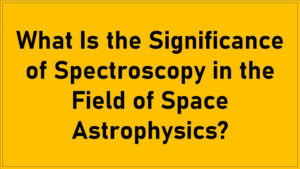
Introduction.
In this article, I’ll delve into the captivating realm of space astrophysics and explore the profound significance of spectroscopy within this field. Astrophysics, the branch of astronomy that studies the physical properties and behavior of celestial objects, has been revolutionized by the invaluable insights offered by spectroscopy. Spectroscopy, the science of analyzing light or other electromagnetic radiation emitted or absorbed by matter, has become an indispensable tool in unraveling the mysteries of the universe. Its role in space astrophysics extends far beyond mere observation; it serves as a key to deciphering the composition, temperature, density, and motion of distant celestial bodies, enabling us to unlock the secrets of the cosmos.
Through the study of spectra, space astrophysicists gain access to a wealth of information about stars, galaxies, and other cosmic entities, shedding light on their origins, evolution, and fundamental properties. From identifying the chemical elements present in distant stars to probing the expansion of the universe itself, spectroscopy allows us to peer into the cosmic past, present, and future. As we delve deeper into this article, we will uncover how spectroscopy has transformed our understanding of space astrophysics, leading to groundbreaking discoveries and shaping the course of modern astronomy.
- Studying celestial objects’ composition, temperature, and density.
- Analyzing light spectra reveals chemical elements and physical conditions.
- Identifying distant galaxies, stars, and exoplanets through spectroscopy.
- Understanding the universe’s history and evolution via spectral data.
- Detecting cosmic phenomena like black holes, quasars, and supernovae.
- Assessing cosmic expansion and the nature of dark matter and energy.
Studying celestial objects’ composition, temperature, and density.
Spectroscopy plays a pivotal role in space astrophysics by enabling scientists to decipher crucial information about celestial objects. When light from distant stars, galaxies, or other cosmic bodies reaches our telescopes, it carries a wealth of information encoded in its spectrum. Spectroscopy involves splitting this light into its constituent colors and analyzing the resulting spectra. This process allows scientists to determine the chemical composition, temperature, and density of celestial objects.
By studying the spectra of stars, for instance, astronomers can identify the elements present in their atmospheres. Each element absorbs and emits light at specific wavelengths, creating a unique spectral fingerprint. Analyzing these fingerprints helps astronomers understand the elemental makeup of stars, shedding light on their lifecycle, and even predicting their fate, whether they will become supernovae, white dwarfs, or other stellar remnants.
Spectroscopy also aids in investigating celestial bodies beyond our solar system, such as exoplanets. By analyzing the light that passes through the atmospheres of these distant worlds, scientists can deduce the chemical composition and temperature gradients of these alien environments. This information is crucial for assessing the potential habitability of exoplanets and gaining insights into their geology and atmospheres. In summary, spectroscopy’s ability to unveil composition, temperature, and density details is fundamental for understanding the nature and characteristics of celestial objects, furthering our knowledge of the cosmos.
Analyzing light spectra reveals chemical elements and physical conditions.
One of the primary applications of spectroscopy in space astrophysics is the revelation of chemical elements and physical conditions within celestial objects. When light from distant stars, galaxies, or other cosmic entities passes through a spectrograph, it produces a spectrum characterized by distinctive absorption or emission lines. These lines correspond to the wavelengths of light absorbed or emitted by specific elements or molecules present in the object.
By analyzing these spectral lines, scientists can identify the chemical composition of celestial bodies. Each element has a unique set of spectral lines, like a fingerprint, making it possible to determine which elements are present in a star’s atmosphere, a planet’s surface, or the interstellar medium. This information is fundamental for understanding the building blocks of the universe and the processes taking place within it.
Spectroscopy also provides valuable insights into the physical conditions of celestial objects. The widths, shapes, and shifts of spectral lines are sensitive indicators of temperature, pressure, density, and motion. For example, a redshift in a spectrum indicates that an object is moving away from us, which is a key piece of evidence supporting the expansion of the universe (the Big Bang theory). Additionally, the Doppler effect, as observed in spectral lines, helps astronomers determine the velocities of stars, galaxies, and other cosmic bodies.
Identifying distant galaxies, stars, and exoplanets through spectroscopy.
Spectroscopy is instrumental in the field of space astrophysics for identifying and characterizing distant celestial objects, including galaxies, stars, and exoplanets. When astronomers point their telescopes at the night sky, they often encounter numerous points of light. Spectroscopy helps them decipher the nature and properties of these objects.
For galaxies, spectroscopy allows astronomers to determine their redshifts. The redshift of a galaxy’s spectrum is a measure of its recession velocity, which, in turn, provides information about the expansion of the universe. By analyzing the redshifts of distant galaxies, scientists can map the large-scale structure of the cosmos and probe the history of cosmic expansion, leading to key insights into cosmology.
When it comes to stars, spectroscopy unveils a wealth of information. Each star’s spectrum reveals its temperature, chemical composition, luminosity, and even its evolutionary stage. Spectral classification systems, such as the Hertzsprung-Russell diagram, are built upon the data obtained from stellar spectra. This classification helps astronomers categorize stars and understand their life cycles, from birth to death.
Understanding the universe’s history and evolution via spectral data.
Spectral data obtained through spectroscopy plays a pivotal role in unraveling the history and evolution of the universe in the field of space astrophysics. The light from celestial objects carries with it a record of the past, and by analyzing these spectral records, scientists can piece together the cosmic narrative.
One of the most profound insights derived from spectral data is related to the cosmic microwave background radiation (CMB), often referred to as the “afterglow” of the Big Bang. Spectroscopic measurements of the CMB have provided precise information about the early universe’s temperature, density, and composition. These findings corroborate the Big Bang theory and offer crucial details about the universe’s first moments.
Additionally, the study of spectra from distant galaxies allows astronomers to examine the evolution of the cosmos over vast time scales. By analyzing the redshifts of galaxies at different distances, they can trace the expansion of the universe backward in time. This has led to the discovery of dark energy, a mysterious force driving the universe’s accelerated expansion, which has profound implications for the universe’s fate.
Detecting cosmic phenomena like black holes, quasars, and supernovae.
Spectroscopy in space astrophysics plays a critical role in the detection and characterization of various cosmic phenomena, including black holes, quasars, and supernovae. These exotic objects and events often exhibit unique spectral signatures that provide valuable information about their properties and behavior.
Black holes, for example, are known for their immense gravitational pull, which can trap even light. However, the matter falling into a black hole emits intense radiation before crossing the event horizon. Spectroscopy allows astronomers to detect and analyze this radiation, revealing the presence of black holes and providing insights into their mass, spin, and accretion processes.
Quasars, some of the most luminous and energetic objects in the universe, emit powerful radiation across a broad range of wavelengths. Spectroscopy helps identify quasars by their distinctive spectra, characterized by strong emission lines. The study of quasar spectra informs researchers about the nature of supermassive black holes at their cores and the surrounding environments.
Assessing cosmic expansion and the nature of dark matter and energy.
Spectroscopy plays a crucial role in the ongoing assessment of cosmic expansion and the quest to understand the nature of dark matter and dark energy, two of the most enigmatic components of the universe.
The measurement of redshifts in the spectra of galaxies, a phenomenon known as the cosmological redshift, is fundamental to our understanding of cosmic expansion. Spectroscopy allows astronomers to precisely determine the redshift of distant galaxies, which indicates their recession velocity due to the expansion of the universe. This information has been instrumental in confirming the Big Bang theory and estimating the rate of cosmic expansion, known as the Hubble constant.
Dark matter, a mysterious substance that makes up a significant portion of the universe’s mass, does not emit or absorb light, making it invisible to traditional observation methods. However, its presence can be indirectly inferred through gravitational effects on visible matter. Spectroscopy plays a role in mapping the distribution of visible matter, such as galaxies and galaxy clusters, and their motion due to gravitational forces. These measurements help constrain the distribution of dark matter in the universe.
Conclusion.
I hope this discussion has shed light on the profound significance of spectroscopy in the realm of space astrophysics. Spectroscopy serves as an invaluable tool for astronomers and astrophysicists, allowing them to unravel the mysteries of the universe. By dissecting the light emitted or absorbed by celestial objects, spectroscopy unveils crucial information about their composition, temperature, density, and motion. Through the study of spectral lines, scientists can determine the chemical composition of stars, galaxies, and even distant exoplanets, helping us better understand the cosmos.
Moreover, spectroscopy has revolutionized our understanding of the universe’s history and evolution. It has enabled the discovery of dark matter, illuminated the nature of black holes, and provided insight into the expansion of the universe itself. In essence, spectroscopy serves as a powerful bridge between the observable and the invisible, connecting us to the vast wonders of space. As technology advances, we can only anticipate more exciting discoveries and a deeper understanding of the universe through the continued application of spectroscopic techniques in space astrophysics.










